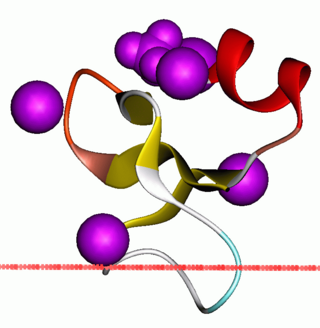Related Research Articles

Defensins are small cysteine-rich cationic proteins across cellular life, including vertebrate and invertebrate animals, plants, and fungi. They are host defense peptides, with members displaying either direct antimicrobial activity, immune signaling activities, or both. They are variously active against bacteria, fungi and many enveloped and nonenveloped viruses. They are typically 18-45 amino acids in length, with three or four highly conserved disulphide bonds.

Hemoglobin subunit delta is a protein that in humans is encoded by the HBD gene.

Beta-defensin 2 (BD-2) also known as skin-antimicrobial peptide 1 (SAP1) is a peptide that in humans is encoded by the DEFB4 gene.

Alpha defensins are a family of mammalian defensin peptides of the alpha subfamily. In mammals they are also known as cryptdins and are produced within the small bowel. Cryptdin is a portmanteau of crypt and defensin.

Beta defensins are a family of vertebrate defensins. The beta defensins are antimicrobial peptides implicated in the resistance of epithelial surfaces to microbial colonization.

Beta-defensin 1 is a protein that in humans is encoded by the DEFB1 gene.

Beta-defensin 103 is a protein that in humans is encoded by the DEFB103A gene.

Arthropod defensins are a family defensin proteins found in mollusks, insects, and arachnids. These cysteine-rich antibacterial peptides are primarily active against Gram-positive bacteria and fungi in vitro. However Drosophila fruit flies mutant for the fly defensin were more susceptible to infection by the Gram-negative bacteria Providencia burhodogranariea, and resisted infection against Gram-positive bacteria like wild-type flies. It remains to be seen how in vitro activity relates to in vivo function. Mutants for the defensin-like antimicrobial peptide Drosomycin were more susceptible to fungi, validating a role for defensin-like peptides in anti-fungal defence.

ETS-related transcription factor Elf-4 is a protein that in humans is encoded by the ELF4 gene.

Defensin, alpha 5 (DEFA5) also known as human alpha defensin 5 (HD5) is a protein that in humans is encoded by the DEFA5 gene. DEFA5 is expressed in the Paneth cells of the ileum.

Beta-defensin 104 is a protein that in humans is encoded by the DEFB104A gene.

Beta-defensin 106 is a protein that in humans is encoded by the DEFB106A gene.

Beta-defensin 118 is a protein that in humans is encoded by the DEFB118 gene.

Beta-defensin 127 is a protein that in humans is encoded by the DEFB127 gene.

Beta-defensin 105 is a protein that is encoded by the DEFB105A gene in humans.

Beta-defensin 119 is a protein that in humans is encoded by the DEFB119 gene.

Beta-defensin 126 is a protein that in humans is encoded by the DEFB126 gene.

Beta-defensin 129 is a protein that in humans is encoded by the DEFB129 gene.

Defensin, alpha 6 (DEFA6) also known as human alpha defensin 6 (HD6) is a human protein that is encoded by the DEFA6 gene. DEFA6 is expressed in the Paneth cells of the ileum.
Virtual colony count (VCC) is a kinetic, 96-well microbiological assay originally developed to measure the activity of defensins. It has since been applied to other antimicrobial peptides including LL-37. It utilizes a method of enumerating bacteria called quantitative growth kinetics, which compares the time taken for a bacterial batch culture to reach a threshold optical density with that of a series of calibration curves. The name VCC has also been used to describe the application of quantitative growth kinetics to enumerate bacteria in cell culture infection models. Antimicrobial susceptibility testing (AST) can be done on 96-well plates by diluting the antimicrobial agent at varying concentrations in broth inoculated with bacteria and measuring the minimum inhibitory concentration that results in no growth. However, these methods cannot be used to study some membrane-active antimicrobial peptides, which are inhibited by the broth itself. The virtual colony count procedure takes advantage of this fact by first exposing bacterial cells to the active antimicrobial agent in a low-salt buffer for two hours, then simultaneously inhibiting antimicrobial activity and inducing exponential growth by adding broth. The growth kinetics of surviving cells can then be monitored using a temperature-controlled plate reader. The time taken for each growth curve to reach a threshold change in optical density is then converted into virtual survival values, which serve as a measure of antimicrobial activity.
References
- ↑ Bensch KW, Raida M, Mägert HJ, Schulz-Knappe P, Forssmann WG (July 1995). "hBD-1: a novel beta-defensin from human plasma". FEBS Letters. 368 (2): 331–5. doi: 10.1016/0014-5793(95)00687-5 . PMID 7628632. S2CID 84766207.
- ↑ Dhople V, Krukemeyer A, Ramamoorthy A (September 2006). "The human beta-defensin-3, an antibacterial peptide with multiple biological functions". Biochimica et Biophysica Acta (BBA) - Biomembranes. 1758 (9): 1499–512. doi:10.1016/j.bbamem.2006.07.007. PMID 16978580.